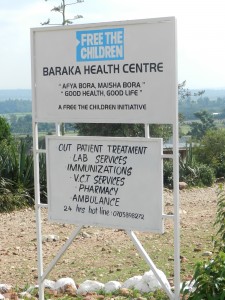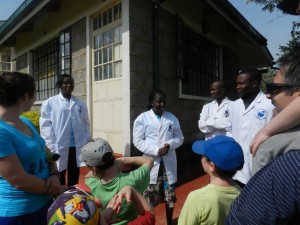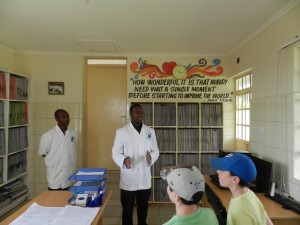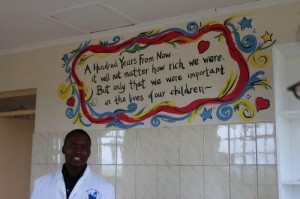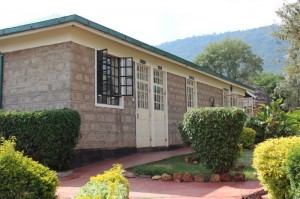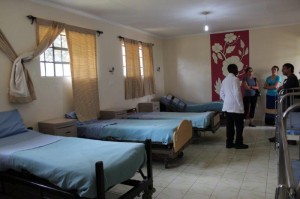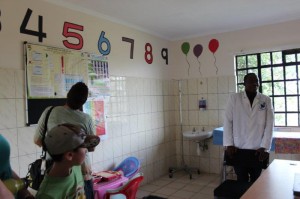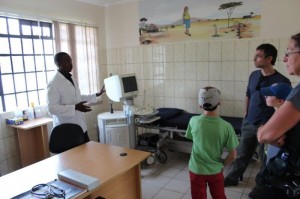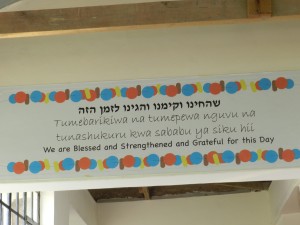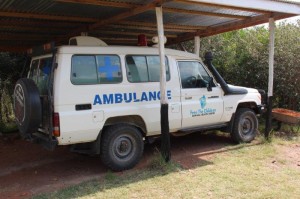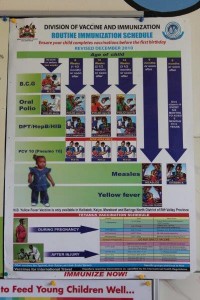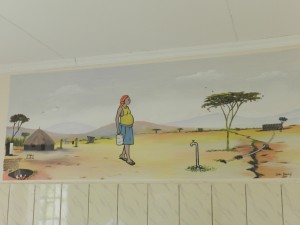March 12
Our tour of the area during this trip had already exposed us to the pillars of education, water source and security, and alternative income sources to empower women and men. Only the health care pillar and agriculture and food security remained.
Today, toured the Baraka Health Centre, built by Free the Children to provide free open access to health care. Baraka in Swahili means “blessing” (derived from Arabic). The clinic certainly seems to be a blessing for the community.
Built much like other African medical clinics or hospitals, the floors are red and the hallways are outdoors. The walls are white and the furniture is sparse. One difference here is the plethora of inspirational Kenyan and Free the Children quotes and murals covering the walls. From registration to trauma/treatment to the paediatric and immunization clinic to the obstetrics ward, the mood is upbeat.
Also, the clinic is very clean and the gardens well-kept and even medicinal. Even though there is no surgery or in-patients here (yet), they have an ambulance! It gets used about once daily, mostly for motorcycle crashes, since the roads are awful and no one wears a helmet, whether driving or one of up to two passengers.
Circumcision of males has at least half moved to the clinic, from the community, providing more sanitary conditions for the procedure. We did not meet the physician assistant working, as he was with a patient, so unfortunately we could not exchange circumcision tips.
We did have a great tour led by the nurse who manages the clinic. He seems insightful and flexible to the needs of the community. All of the staff are very friendly, but we were especially impressed with his approach to managing the clinic and working with the community to improve health. Due to the elevation in this area, over 5000 feet, malaria cases only come from away. HIV is not very prevalent, but their clinic is growing. The immunization clinic is growing as the community begins to embrace the benefits of obstetrics.
Just over a year ago, Baraka began to do deliveries. Already, half of the babies born in the community surrounding the clinic are born in the clinic, which amounts to about fifteen monthly. Medications for labour include oral pain medication or an injection of an anti-inflammatory. Women are able to stay for observation for 1-2 days, but almost all go home within twelve hours. Certainly having your baby in the clinic means someone else cleans up the mess!
The only cost for patients is medications and labs, mostly to get a commitment from the patient to take the medications prescribed. Even in Kenya, patients don’t take their medications! Patients pay for tests, to recoup expensive costs, but HIV tests are done on everyone for free, and obstetrics are also free, in order to help compliance and to produce healthy babies.
A lot of the health improvements occurred back in people’s huts through education. Eight specific improvements were implemented: chimneys by the kitchen fires to allow venting and better breathing; a dug-out latrine for each home to contain human wastes; Clean water for drinking as well as soap for hand washing after latrine use; clotheslines to stop bugs from infesting clothes; dishwashing racks outside the home to keep kitchen waste outside and control disease; pens for animals outside the home to control disease; small enclosed areas to allow daytime showers; compost piles separated from burned garbage; home gardens to save money. These interventions greatly reduced cholera and typhoid in the community. This is a mural in the clinic, illustrating the eight points of education, to ensure a healthy home.
Overall, it seems there is a transformation occurring in this community, amongst the various tribes. Health and standard of living are slowly improving, with the implementation of the five pillars promoted by Free the Children, while efforts are made to maintain elements of the unique culture of each tribe.
After we spent the afternoon working further at the Kisaruni Girls High School build site, we reconvened by the fire to hear stories from Wilson and Jackson. Next post we will share what we learned from them about the Maasai culture.
posted by Aubrey

